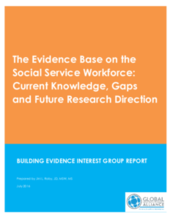This is a report commissioned by the Building Evidence for Social Service Workforce Strengthening Interest Group (BEIG) of the Global Social Service Workforce Alliance. The purpose of this report is to review the current conditions of the global social workforce. This study is meant to identify critical gaps in order prioritize current workforce strengthening research.
The report is based on 266 works published after 2010. The results reveal that there is limited research in regard to the strengthening of the global social service workforce. Most significant works come from high income countries and mostly ignore low-to-middle income countries. Low-to-middle income country research is starting to emerge in the forms of case studies, situational analysis and technical reports. Due to lack of research, a true gap analysis cannot be made, but helpful directional information has been extracted.
In the area of planning a social service workforce, the report discusses how planning a workforce is often based on a cluster of laws. Additionally, mapping and country studies are found helpful in workforce planning. When considering the development of a social service workforce, it is important to consider education and training for the purpose of aligning members of the workforce with the needs of the area. Education and training is something that should be maintained throughout all stages of planning and implementing of a workforce.
Among its many findings, the study found that there is a large amount of research surrounding clusters in Africa. Recently, there was a report from the Southeastern European region and several from Southeast Asia and the Caribbean. The study found that overall low-to-middle income country policies tend to speak in broad terms. Research suggests that retention of the social service workforce is a challenge in most regions, due to low salaries, caseloads, and professional stature.

